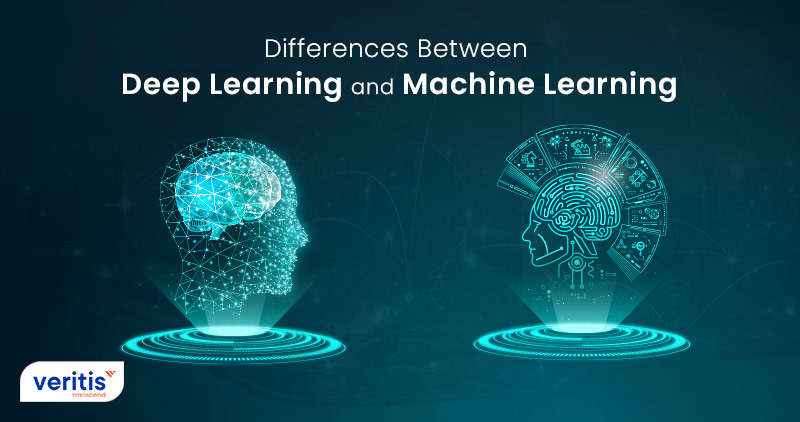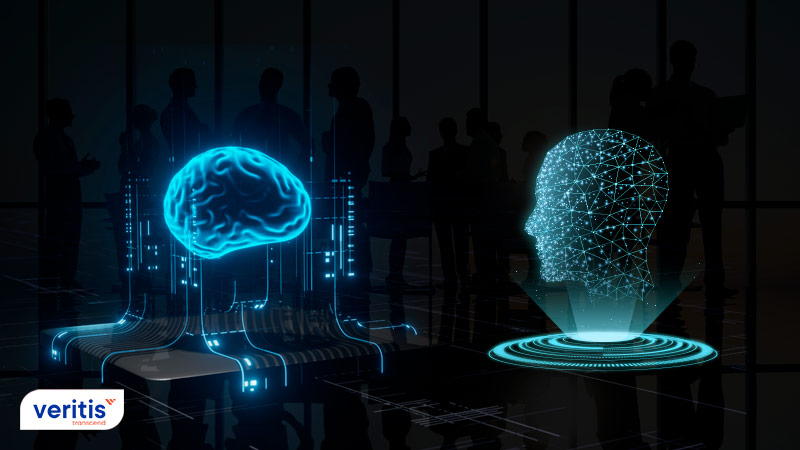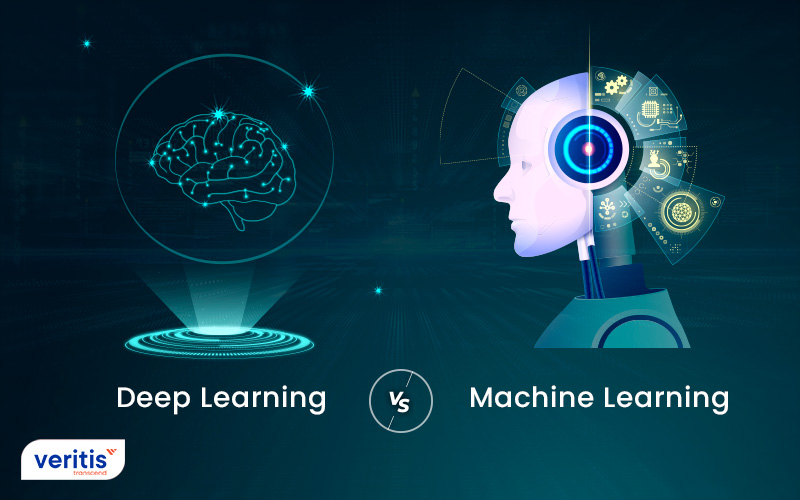
Table of contents
Technologies have become increasingly integrated into our day to day operations, and organizations are relying heavily on deep learning and machine learning algorithms to keep pace with the rapid growth in consumer demand. You can see its application on social media through object recognition in photos, or by interacting directly with devices like Siri or Alexa.
Machine learning and deep learning concepts have undergone groundbreaking developments in artificial intelligence (AI) over the last decade, reshaping the world around us. Businesses are drawn to the opportunities to invest in emerging technologies, including AI and blockchain. However, Deep Learning and Machine Learning are terms related to artificial intelligence, and their definitions may appear interchangeable to newcomers.
Deep learning and machine learning have recently experienced a golden era, as these applications have become increasingly ubiquitous. In addition, these technologies have become increasingly personalized in our interactions with them. For instance, chatbots can be annoying and still pretty clumsy in their current state, but they are evolving. They have become conversational, learn human characteristics, enhance the user experience, and complement your customer service approach.
According to the Comet survey, 508 ML practitioners reported that 58 percent use manual tools to track ML experiments, and 47 percent said ML teams require 6 months to deploy a single ML project. Moreover, 88 percent of respondents have a budget of less than USD 75,000 for MLOps tools and infrastructure.
Echoing similar sentiments for deep learning are other surveys. Grand View Research predicted that global deep learning industry market size is estimated to grow USD 526.7 billion at a CGAR of of 31.8% from 2025 to 2030.
Your organization can decide which one to implement based on the business requirements. Let’s explore the concepts before diving into the topic’s crux.
Get a Personalized Strategic Assessment
Useful Link: 10 Ways Artificial intelligence (AI) is Transforming DevOps
What is Deep Learning (DL)?

The term deep learning was coined 79 years ago. In 1943, mathematician Walter Pitts and neurophysiologist Warren McCulloch collaborated to develop a computer based model. They then began translating neural networks into computational systems of the human brain.
Deep learning is a subset of machine learning and a component of artificial intelligence. It is a powerful tool that uses three or more layers of neural network models to perform sophisticated computations on large datasets.
It is the most crucial element of data science, including predictive modeling and statistics. DL streamlines the process for data scientists and researchers who interpret, analyze, and collect substantial volumes of data.
The Deep learning model has attracted considerable attention because it powers many AI services and applications, including high computing power, improved automation, advances in data center capabilities, and the ability to perform analytical and physical tasks without human intervention. Additionally, deep learning algorithms perform routine, repetitive tasks more efficiently and faster than humans.
Deep learning can benefit real world applications, including voice enabled TV remotes, digital assistants, credit card fraud detection, and emerging technologies such as self driving cars.
In deep learning, models operate across multiple layers to extract insights from the data. Some of the best deep learning models are:
- Recurrent Neural Network
- Convolutional Neural Network
- Autoencoders
- Classic Neural Networks and more
Key features of Deep Learning:
- Neural networks with hidden layers process data in a way that mimics human cognition.
- Requires large scale labeled datasets to perform effectively.
- Benefits from advanced hardware such as GPUs and TPUs for high performance training.
- Often considered a “black box” because of its complexity and lack of interpretability.
Example applications:
- Voice assistants like Alexa and Siri are used for speech recognition and response.
- Autonomous vehicles using real time object detection.
- Medical imaging for disease diagnosis.
- Generative AI models, such as GPT and BERT, are used for a range of tasks, including text, image, and multimodal applications.
How Does Deep Learning Work?
Let’s start with the algorithm’s working principle before moving to the deep learning model. For instance, we are all familiar with neurons in the brain (cells) that receive inputs from sensory organs, such as the ears and eyes. When a neuron receives an input signal, it transmits it through its body and becomes activated, producing an output. This output will stimulate other neurons to fire, enabling a complete picture.
Understanding how deep learning works with the above instance, the deep learning model takes the images as input and feeds them directly to the algorithms without any manual feature extraction step. The input is passed through multiple layers of the AI neural network to estimate the final output.
What is Machine Learning (ML)?

Arthur Samuel coined the term “machine learning” in 1959 and is a pioneer in artificial intelligence and computer gaming. Over the past few years, top MNCs have invested significantly in this technology, leaving no stone unturned to stay at the forefront of today’s IT landscape.
Machine learning (ML) is a branch of artificial intelligence that enables systems to adapt to new data autonomously and through iterative processes. It is a data analytics process that automatically accesses data and performs tasks based on detections and predictions. ML focuses on developing computer programs that learn from data, make decisions, and identify patterns, with minimal human intervention.
Machine learning is a subfield of artificial intelligence that develops software that automatically learns from past data, builds knowledge, and gradually improves its performance, making accurate predictions on new data.
ML is one of the most pivotal and commanding technologies one has ever encountered. Despite the scope of improvement and investment, developing, maintaining, and training ML models has been an ad hoc, cumbersome process. This is where MLOps solutions come into play, offering a streamlined approach to managing and operationalizing machine learning models. MLOps solutions automate and optimize the deployment, monitoring, and management of ML models, reducing friction in turning machine learning into impactful business solutions.
Machine learning is crucial for aspiring data scientists and analysts, as well as those aiming to transform large volumes of raw data into predictions. Deep learning and machine learning are subsets of artificial intelligence; both use data to learn.
Key features of Machine Learning:
- Utilizes statistical models like linear regression, logistic regression, support vector machines, and decision trees
- Requires feature engineering, a critical process where human experts identify the most relevant input variables, thereby underlining the significance of your role in the process.
- Offers greater interpretability, a key feature that makes it easier to explain results in regulated industries like finance or healthcare, thereby ensuring its applicability and relevance.
Example applications:
- Email spam detection using classification algorithms.
- Predictive analytics in business forecasting.
- Fraud detection in banking systems.
How Does Machine Learning Work?
Machine learning primarily involves two different approaches: supervised learning and unsupervised learning.
Useful Link: Top 15 AWS Machine Learning Tools in the Cloud
A) Supervised Learning
Supervised learning is an algorithm that learns from labeled training data to enable machines to predict their output. It deals with the unlabelled data. It is a subcategory of machine learning and artificial intelligence.
B) Unsupervised Learning
Unsupervised learning utilizes machine learning algorithms to cluster and analyze hidden patterns in input data, regardless of the output. It allows users to perform more complicated tasks compared to supervised learning. Unsupervised learning algorithms encompass neural networks, clustering, anomaly detection, and other techniques.
Comparison Between Deep Learning and Machine Learning

Let’s explore the differences between deep learning and machine learning on different parameters.
| Details | Deep Learning | Machine Learning |
| Model | It is a specialized subset of machine learning. While it comes under the broad category of artificial intelligence | It is a subset of artificial intelligence and a superset of deep learning |
| Data dependency | DL algorithms need massive data, and users must feed that vast amount for better performance. | Even though ML depends on a vast volume of data, it can also manage a smaller amount of data. |
| Data representation | Deep learning data differs entirely from machine learning, which runs neural networks. | Data performed in machine learning is wholly different from deep learning in that it runs structured data. |
| Number of data points | Deep learning can use thousands of data points to make predictions | Machine learning can use millions of data points to make predictions |
| Execution time | Deep learning usually takes a long execution time to train the model but less time to test it. | ML algorithm comparatively takes less time to train the model but takes a long time to test the model. |
| Accuracy | It enables faster and more accurate results | It has low accuracy results |
| Performance | It shows better performance on massive datasets | It shows good performance on small and medium size datasets |
| Hardware dependencies | It works on high end machines | It works on low end machines |
| Featurization Process | It requires high level features from data and develops new features by itself. | Needs features to be identified accurately and created by users |
| Output | DL output is usually a numeric value like a score or a classification | ML output has numerous formats, such as score, sound, or text |
| Problem solving approach | The DL model’s problem solving approach is entirely different from the traditional ML model. It takes input and produces the result, following an end to end approach. | The traditional ML model breaks the problem into subfields, and after solving each product, it gives the final result. |
| Introduced | The term deep learning was coined by mathematician Walter Pitts and neurophysiologist Warren McCulloch in 1943 | Arthur Samuel coined the term machine learning in 1959 |
| Interpretation of result | When working with a deep learning model, interpreting the result for a given problem is complex. | When working with a machine learning model, interpreting the result for a given problem is easy. |
| Feature Engineering | In deep learning, there is no need for feature engineering as the neural network automatically detects essential features. | In machine learning, feature engineering is done by humans |
| Type of data | The deep learning model mainly works with structured and unstructured data | Machine learning models work with a structured form of data |
| Suitable for | It is suitable for solving complex problems | It is suitable for solving simple problems |
| Human Intervention | The deep learning model permits learning features without additional human involvement. | In the machine learning model, humans must identify and hand code the applied features depending on different data types, such as orientation, shape, pixel value, etc. |
| Applications | DL is used in applications such as healthcare, self driving cars, advanced video game AI, biometrics, and search engines like image search and text search. | ML is used in data analytics, facial recognition, fraud detection, vehicle number plate identification, customer service, finance and banking, and manufacturing applications. |
| Training | It trains on Graphics Processing Unit (GPU) for proper training | It trains on the Central Processing Unit (CPU) for proper training |
| Tuning capability | It can be tuned in numerous ways | The ML model has limited tuning capability for hyperparameter |
| Training dataset | Huge volume | Small volume |
| Choose features | No | Yes |
| Number of algorithms | Few | Many |
Download PDF
Common Misconceptions About ML and DL
When discussing the difference between deep learning and machine learning, several misconceptions arise:
1) “Deep Learning will replace Machine Learning” – Incorrect.
Deep learning is not a replacement for machine learning, but rather a subset that coexists and complements it. This understanding should reassure you about the stability and continuity of the field.
2) “Machine Learning cannot handle unstructured data” – Misleading.
While ML can process unstructured data, it usually requires manual preprocessing. DL automates this step at scale.
3) “Deep Learning always delivers better results” – Not always true.
Deep learning excels in areas such as computer vision and natural language processing. Still, ML is often more efficient, cost effective, and explainable in industries such as finance, healthcare, and law, where transparency is crucial.
4) “Machine Learning is outdated” – A myth.
Even in 2025, machine learning remains a widely used and relevant technology. Its lighter, faster, and easier implementation in many scenarios reassures you about its prospects.
Real World Applications of Machine Learning vs Deep Learning
1) Machine Learning Applications:
- Email spam filters leveraging logistic regression and decision trees.
- Credit scoring models in banking are used to assess the risk associated with loans.
- Predictive maintenance in manufacturing reduces equipment downtime.
2) Deep Learning Applications:
- Voice assistants like Google Assistant use neural networks.
- Self driving cars, where deep learning manages vision systems.
- Healthcare imaging, identifying tumors in X rays and MRIs with high accuracy.
3) Hybrid Applications:
- Autonomous driving combines both: DL manages image recognition, while ML handles route optimization and decision making logic.
Trends in 2025: Generative AI, AutoML, and Beyond
Innovations are reshaping the future of machine learning and deep learning:
- Generative AI: With transformer models like GPT, BERT, and Stable Diffusion, deep learning now powers applications in content creation, chatbots, and multimodal AI experiences.
- AutoML (Automated Machine Learning): ML is becoming more accessible through platforms that automate model selection, training, and deployment, allowing businesses to scale AI without deep technical expertise.
- Explainable AI (XAI): As regulations around AI tighten, machine learning’s interpretability remains crucial for compliance heavy industries like finance and healthcare.
- Balanced Adoption: Enterprises are adopting a hybrid strategy, using ML for efficiency and explainability, and DL for handling complex, large scale, unstructured datasets.
Case Study: Healthcare Transformation with MLOps Frameworks
A leading healthcare provider partnered with Veritis to integrate MLOps frameworks into their data science operations, enhancing machine learning model deployment and monitoring within their clinical systems.
Challenge: The organization faced challenges in managing complex ML models, particularly around deployment, monitoring, and ensuring continuous model updates across multiple healthcare applications.
Solution: Veritis implemented a robust MLOps framework, enabling the seamless deployment, monitoring, and management of machine learning models. The solution incorporated automated testing, real time data analysis, and streamlined collaboration between data scientists and IT teams, ensuring a significant improvement in the efficiency and reliability of models.
Results:
- Accelerated model deployment with automated MLOps pipelines
- Improved accuracy of healthcare models through continuous monitoring
- Enhanced collaboration between data teams and clinical systems, improving patient outcomes
This case highlights the growing importance of MLOps frameworks in healthcare, demonstrating how they bridge the gap between machine learning and real world applications, thereby ensuring that models remain relevant and effective.
Read the full success story: Breaking Barriers in Healthcare With Intelligent MLOps Frameworks
Conclusion on Deep Learning and Machine Learning
Understanding the latest advances in artificial intelligence (AI) might be daunting. Still, if you only want to master the basics, many AI discoveries can be boiled down to two concepts: deep learning and machine learning. There are numerous examples of deep learning and machine learning, which can be observed everywhere.
How self driving cars become a reality, how Netflix predicts which show you’ll like to watch next, and how Facebook detects who is in a photograph. These models seem like interchangeable buzzwords in the artificial intelligence industry, but they have some key differences.
As a result, deep learning is the way to do business if you have enormous data and powerful technology. Otherwise, implement a machine learning model for your business. As you can witness numerous benefits while opting for both these models, picking the best technology is an arduous task that makes it challenging.
Therefore, instead of relying on a single model, why not leverage the benefits of deep learning and machine learning technologies for your business? However, adopting both these technologies is more difficult said than done, which is one of the many reasons enterprises seek Veritis’ assistance.
Are you looking forward to implementing deep learning or a machine learning model in your business? Then Veritis, the Stevie Awards winner, is the right choice to offer digital transformation services for your business. Veritis, the trusted tech partner for Fortune 500 organizations and emerging companies, provides cost effective solutions that do not compromise quality, alongside expert MLOps services to streamline your AI model deployment and operations.